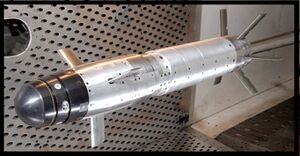N62E1 SONIC
| N62E1 | |
|---|---|
 Prototype N62E0 in testing | |
| Type | Smart Tank Munition |
| Place of origin | |
| Service history | |
| In service | 2018 - present |
| Used by | |
| Production history | |
| Designer | Morales-Sevalière Design Bureau (MSDB) |
| Designed | 2014 |
| Produced | 2016 - present |
| Specifications | |
| Diameter | 120mm |
| Warhead | Explosively Formed Penetrator (EFP) |
Detonation mechanism | Laser Proximity Fuse |
Operational range | 9,000m |
| Speed | 1,850m/s |
Guidance system | Imaging Infrared (IIR) with Millimeter Microwave (MMW) |
The N62E1 SONIC (Stand-Off Non-linear Intelligent Cartridge) is a "smart" tank-shell developed in Inyursta. It is designed for the Entengo 120mm "Marauder" cannon and planned to be deployed on both the YT-3 Crocodile MBT and YT-2 Gavial Tank Destroyer.
Function
First, the target is manually selected by the tank or tank destroyer's crew using the ESQ/GO-22 Electro-optical targeting software (EOTS). The SONIC round is then fired into the air, and keeps track of the target while in flight. A form of "arrested" or "delayed" Proportional navigation is used which keeps the round flying above the most direct path to the target, until the round is almost over the target.
As a top-attack munition, the N62E1 targets the vulnerable upper section of enemy MBT's with an Explosively formed penetrator (EFP). Using a combination of infrared-imaging guidance with millimeter microwave target profiling and active tracking, the munition selects for the top of the turret or rear engine compartment and fires its EFP above the intended impact point.
Warhead diameter is approximately 118mm, with 2kg of Comp-B explosive filing. Lining is comprised of Tantalum for enhanced penetration.
Advantages
Unlike guided artillery shells, the N62E1 puts control of both target identification and engagement in the hands of the tank crew. From an operational standpoint, the tank crew would engage a target with their SONIC shells as they would APFSDS-T or HEAT-AP shells, allowing for more independent tank maneuvers and first-shot, first-kill actions than if they were relying on drones or forward observers.
The flight trajectory also increases the functional range at which tanks and tank destroyers can engage enemy targets, far beyond that of their APFSDS-T shells. Additionally, the high top-attack profile both helps to defeat ERA and APS systems on modern MBTs.
Compared to the GPM-21C gun-launched ATGM, the top-attack + EFP combo allows the munition to "do more with less", leaving more room for guidance nodes, directional controls, propulsion and creating an all-around lighter munition.
Disadvantages
Because the target must be manually selected by the firing tank, enemy vehicles that are concealed or out of the line-of-sight of the gun are unable to be engaged. Likewise, the N62E1 is limited to the range of the tank's targeting software.
Despite being functionally the same gun, the Type-46 Anti-Tank Gun cannot fire this munition as it lacks the targeting software of the YT-3 and YT-2.
Using active MMW radar for target acquisition could potentially result in the tank exposing itself to the enemy; however, not all enemy tanks have RWR systems - or the capacity to shoot first anyways - and in the case of aircraft or drones the launch vehicle would likely already be detected with or without its MMW-R on. In some combat situations, the EOST can be used entirely in passive mode without MMW-R at a cost to range and subject to environmental thermal conditions.